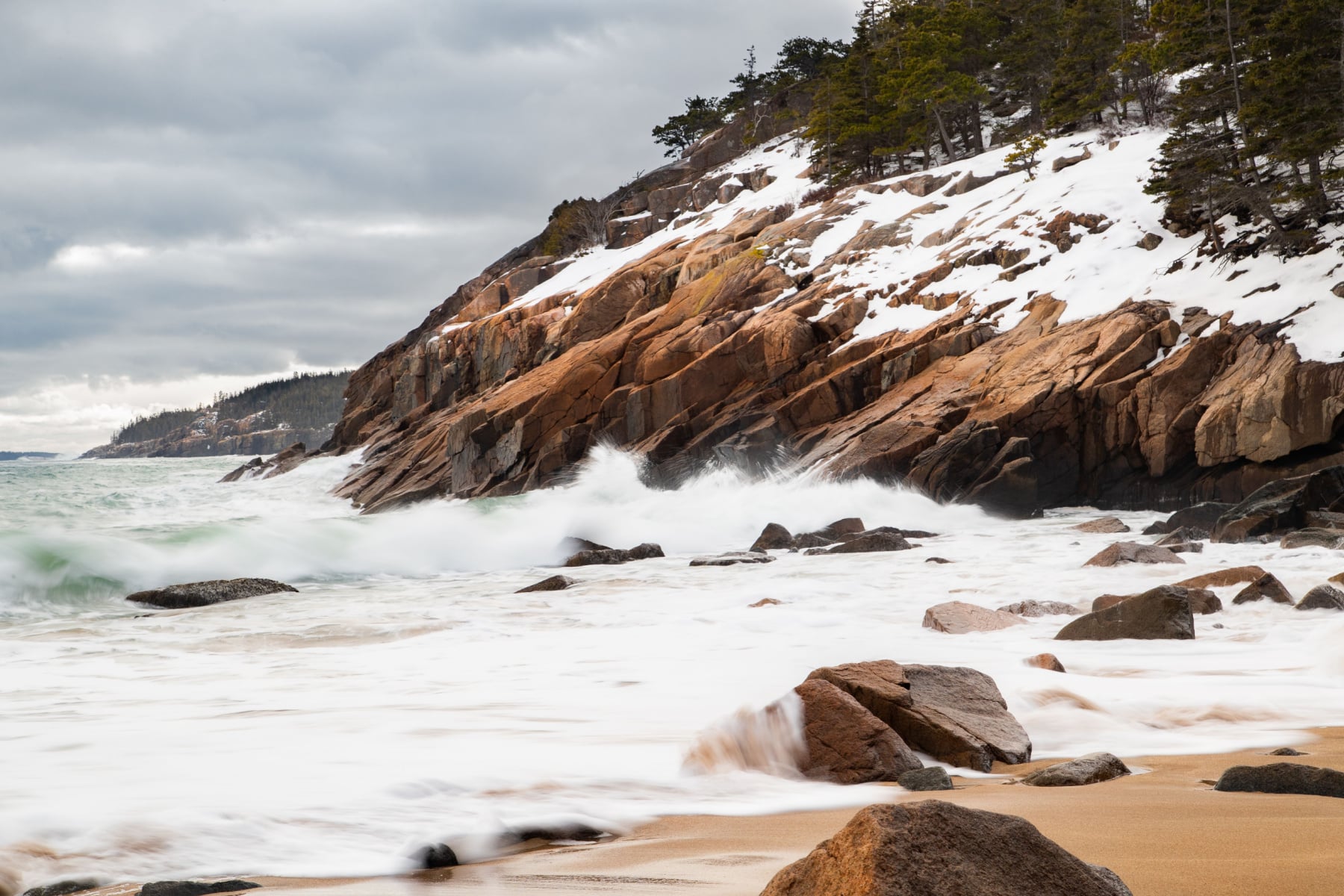
Winter in Acadia National Park offers everything you want in a Downeast winter island getaway – crisp temperatures, up to six feet of snow, and angry waves crashing on the ragged cliffs.
Acadia sits at the heart of Mount Desert Island in Maine, with the other section of the park on Schoodic Peninsula, off the mainland. You can take a ferry to get to the “Quiet Side of Acadia” in winter.
Winter activities include snowshoeing, cross-country skiing, snowmobiling, and even ice climbing. If you don’t mind snow and cold weather and want to beat the crowds, this can be a great time to visit.
Don’t let anyone tell you “Acadia is closed,” because even with the limitations, the winter wonderland is all yours.
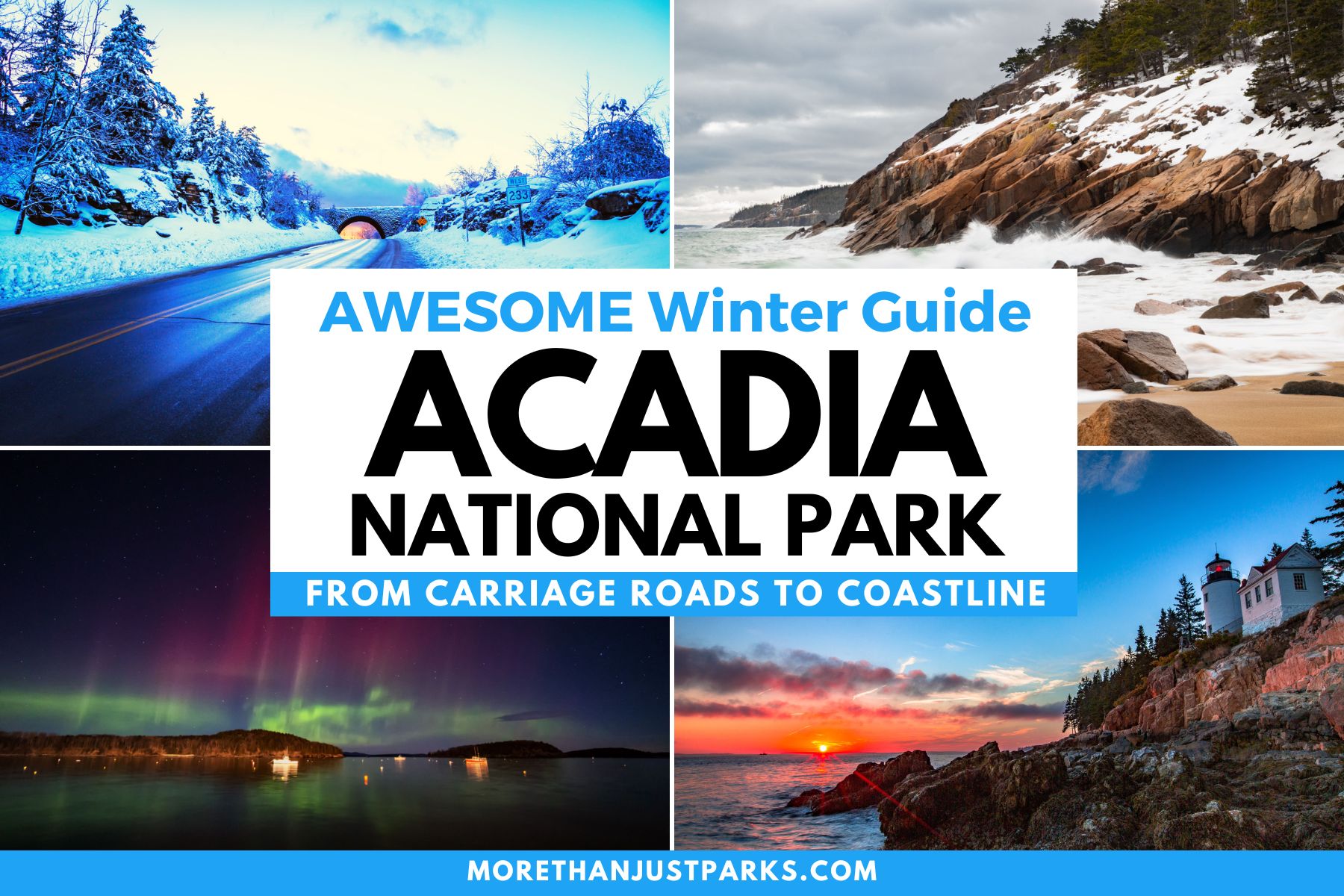
Table of Contents: Acadia in Winter
TAP TO OPEN TABLE OF CONTENTS: Acadia in Winter
Table of contents
- Table of Contents: Acadia in Winter
- 6 Things to Know About Acadia in Winter
- Acadia Winter Weather
- Acadia National Park Map for Winter
- Getting Around Acadia in Winter
- Cadillac Mountain Winter Summit
- Winter Activities at Acadia
- Scenic Drives
- Winter Sunrise and Sunset Times in Acadia
- Pet Rules at Acadia in Winter
- Is Acadia REALLY Worth a Winter Visit?
- WATCH: The Acadia Film in 4K
- Planning an Acadia Trip? We Can Help
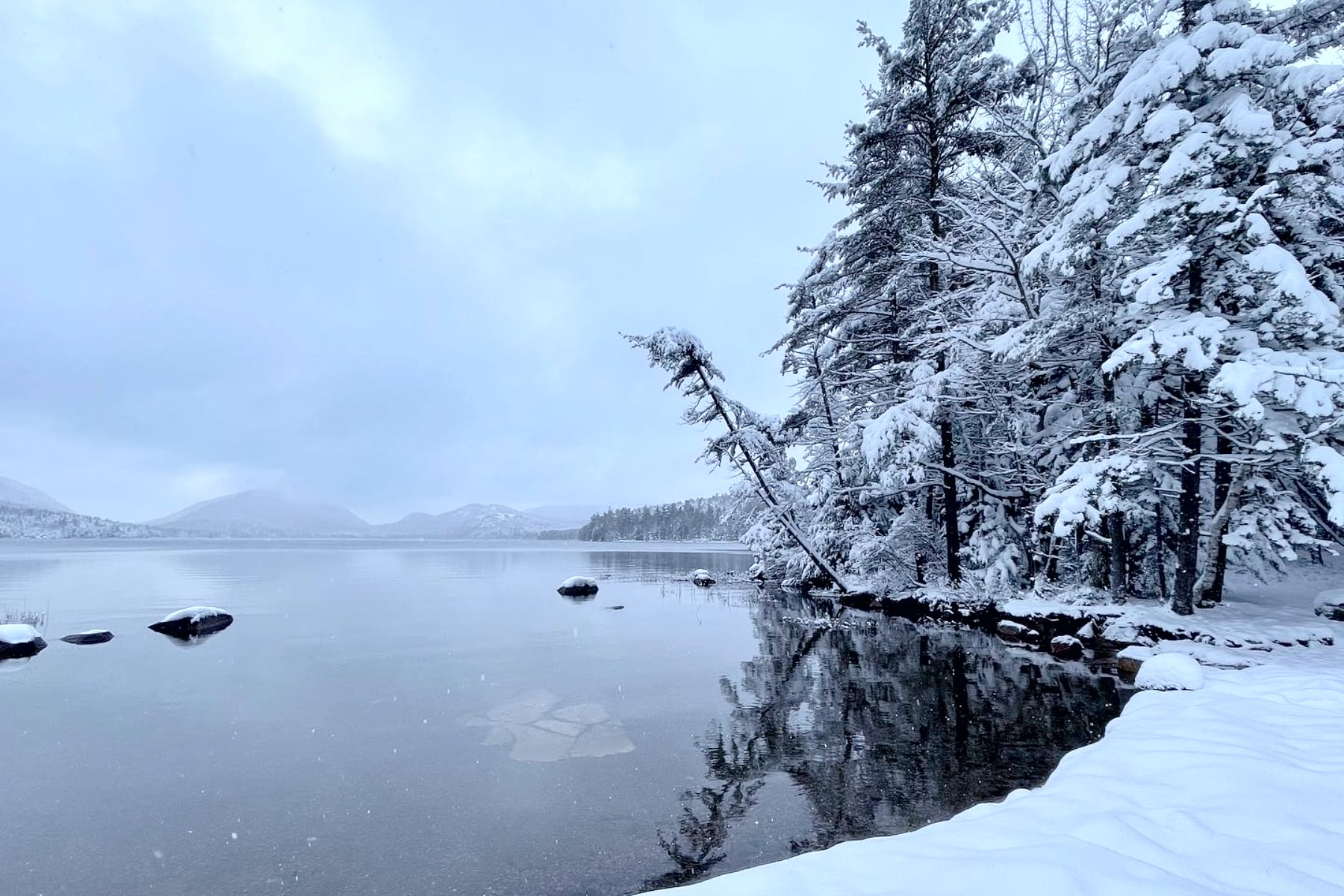
6 Things to Know About Acadia in Winter
- You’ll pay $35 per vehicle or $20 per person if you’re walking through the entrance. If you have an interagency pass, like the America the Beautiful annual pass, you’ll get free entry to Acadia and about 2,000 other public lands for a year.
- Acadia National Park is NOT closed in the winter. Even with the road closures, you’ll still get a lot of land and sea to cover. The miles of carriage roads stay open as weather permits.
- Schoodic Peninsula’s scenic drive and trails are open year-round, weather permitting. Frenchman’s Bay doesn’t freeze over, so a ferry runs back and forth between Bar Harbor and Winter Harbor. You can also drive there in an hour.
- Bar Harbor, Acadia’s anchor town, offers many entertainment and overnight options. This is my favorite hotel, right in the heart of it all. We can confirm the Inn at Mount Desert is open throughout the winter.
- No winter camping of any kind is allowed in the park. Yes, even the popular Schoodic Woods Campground closes. You’ll be hard-pressed to find any campsite near MDI until spring. We called around every campsite we could find, and all are open from May or June through early October.
- The Bar Harbor Chamber of Commerce is the park headquarters for the winter. You’ll find it in town at the corner of Main and Cottage. Save this number in your phone now – (207) 288-3338.

Acadia Winter Weather
Acadia National Park’s winters are cold, which helps the allure of the island for snow seekers. Proper layers are required to enjoy the bounty of carriage roads and coastline walks.
You can expect anywhere from six to twelve inches of snow a month. Since temperatures rarely rise above freezing, even at daytime highs, that snow sticks around through spring. Of course, you can’t bank on having snow either.
Nor’easters pummel the region from fall through spring occasionally, but those come with plenty of advance warning.
| December | 34F / 17F |
| January | 29F / 10F |
| February | 31F / 13F |
| March | 38F / 20F |
Acadia in Winter Weather Resources
We’ve gathered the best weather resources to help you check out the conditions before you go to Acadia’s winter wonderland.
- Acadia Alerts from NPS
- Acadia National Park Weather Website
- New England 511 Road Conditions
- Bar Harbor National Weather Service
- Cadillac Mountain Forecast
- Winter Trail Grooming Report
- Snow Depth Map
It would take a beast of a storm to close down the entire park, but as we saw in December 2023, sometimes it’s for the safety of all guests to close down while a storm passes or so the trails can be groomed.

What to Pack for Acadia in Winter
Acadia’s landscape rises from sea level to 1,530 feet at the top of Cadillac Mountain. Even if it’s raining in Bar Harbor, expect snow, ice, or a mixture of both on the trails as you ascend.
- Crampons: You’ll need these to grip the snowy and icy trails as you explore.
- Snow Goggles: Bring these to prevent the bright landscape from damaging your eyes.
- Stargazing Flashlight: This red-tinted flashlight allows you to see without creating light pollution.
- Waterproof Socks: Keep your feet dry, especially for shoreline walks, with waterproof socks.
- Hiking Boot Gaiters: Keep the snow and water from getting into your hiking boots with waterproof gaiters.
- Trekking Poles: You’ll thank me for this one.
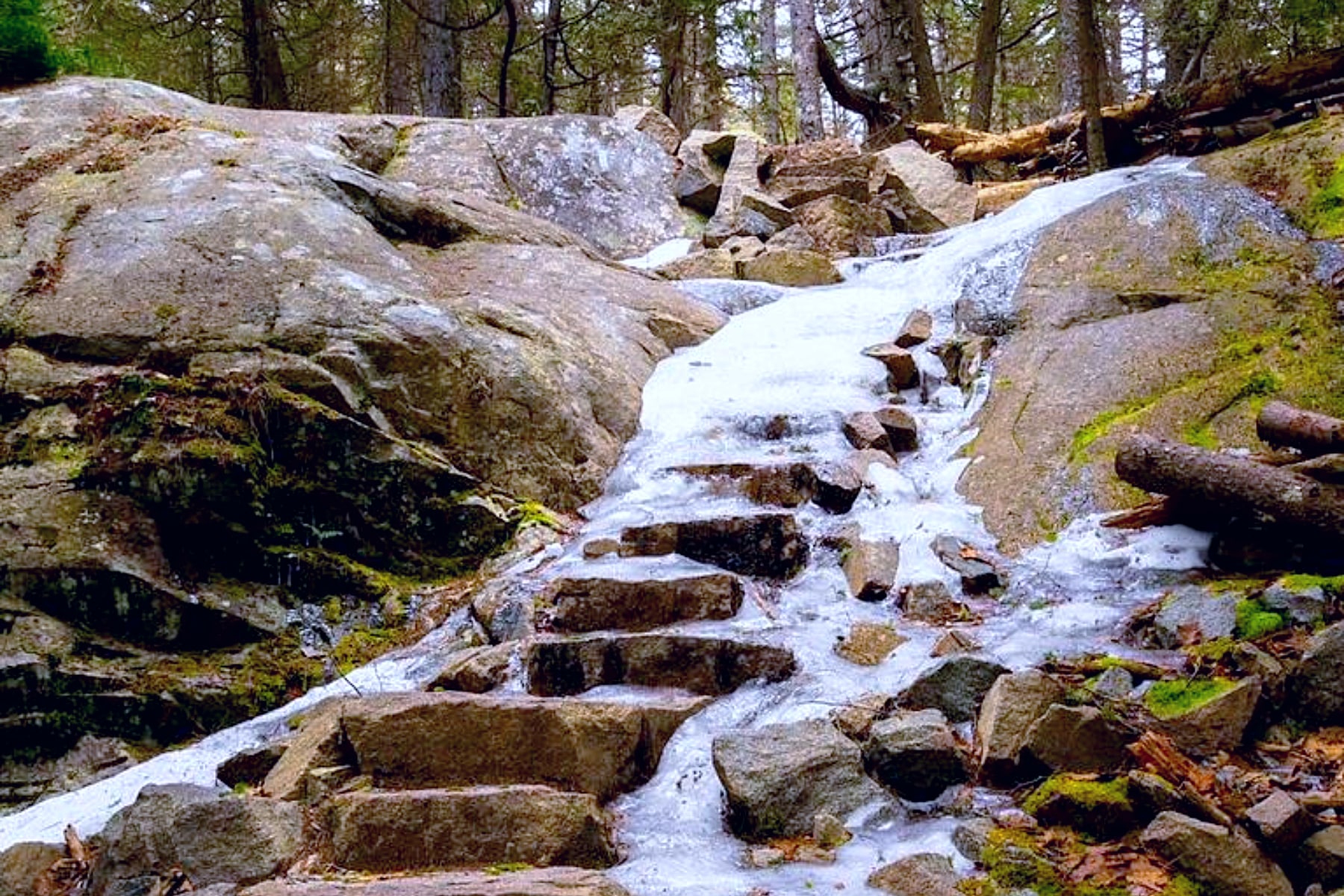
Acadia National Park Map for Winter
We want to set the record straight about what roads are open and closed on Mount Desert Island, home of Acadia National Park, in winter. Arguably the best section of Park Loop Road remains open in the colder months, barring a winter storm. It’s more often referred to as Ocean Drive.
The first thing to know about Mount Desert Island roads in winter is that there’s a difference between Acadia National Park roads and the local roads or state highways. Again, barring bad weather, the state roads are open, which can take you to Southwest Harbor, Bass Harbor and Northeast Harbor.
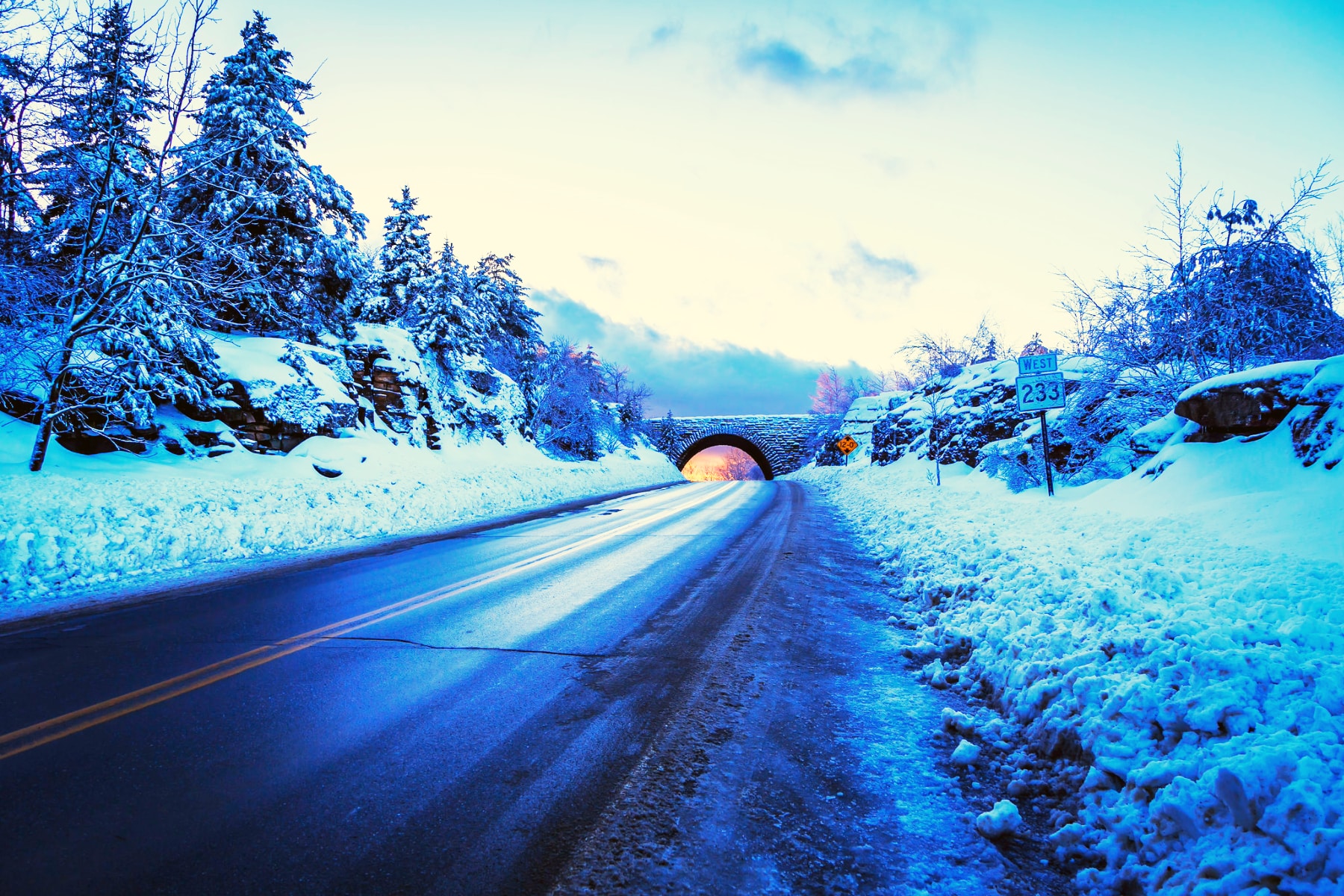
Mount Desert Island in Winter
From Bar Harbor, you’ll take Schoodic Head Road to the Sand Beach entrance, where Park Loop Road’s winter access begins.
Sand Beach Entrance
You’ll travel about two miles on the coastline, with options to stop at Sand Beach and Thunder Hole. Park Loop Road’s winter access ends at Otter Cliff Road, where you’ll turn and follow around until you reach Route 3, which takes you back to Bar Harbor. This is a one-way road, and you must complete the entire loop.
Jordan Pond Entrance
The other access point is on the way to Jordan Pond. From Bar Harbor, you’ll drive around the central section of the park on state highways before taking Peabody Road to wrap around the southern edge of the island. Then, you meet up again with Park Loop Road. This is a two-way road, with Jordan Pond being the turnaround point.
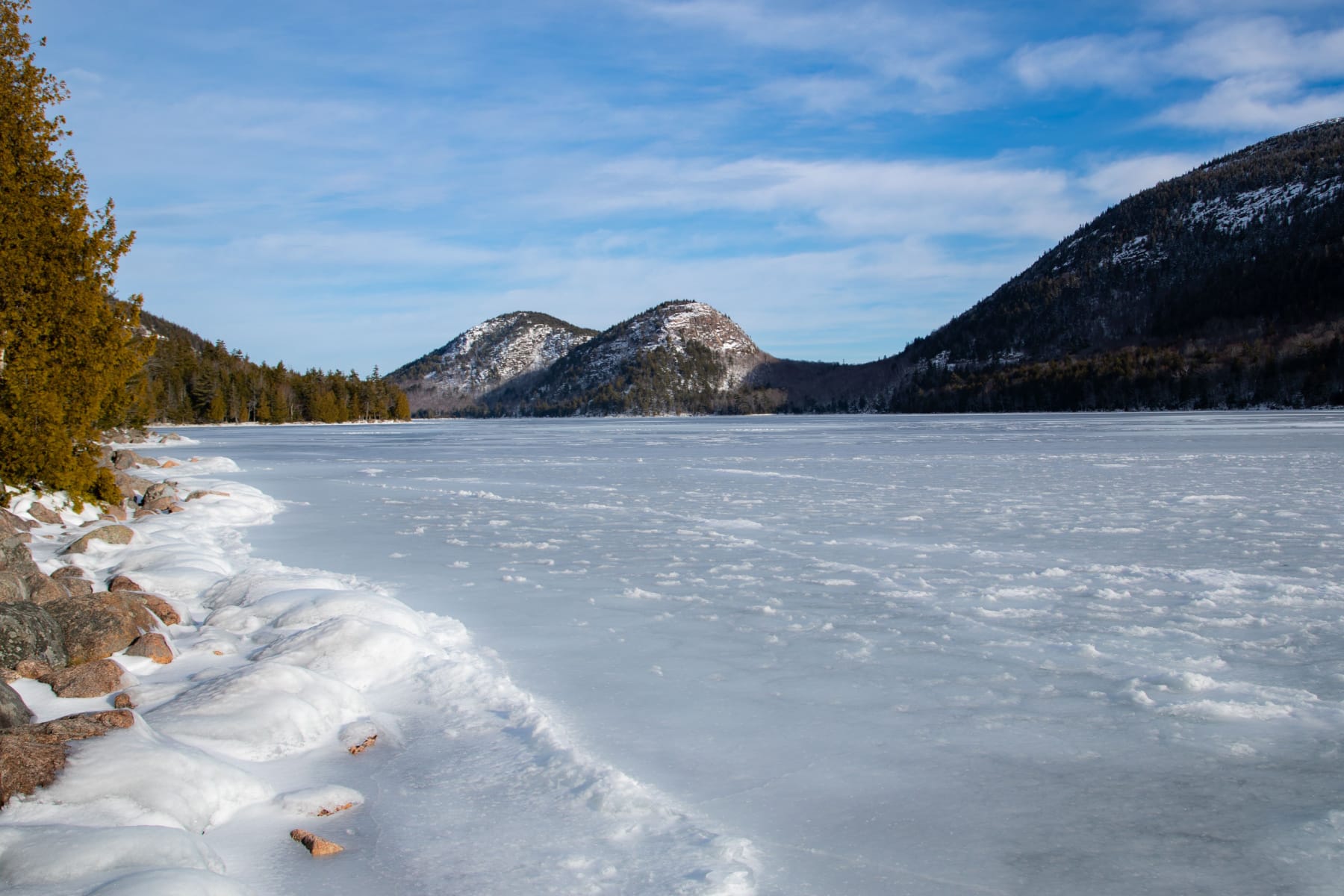
Schoodic Peninsula in Winter
Over on the “Quiet Side,” the six-mile Schoodic Loop Road stays open all winter, with an epic view of the water from Schoodic Point. While you’re there, check out the Schoodic Institute for programs and activities in every season.

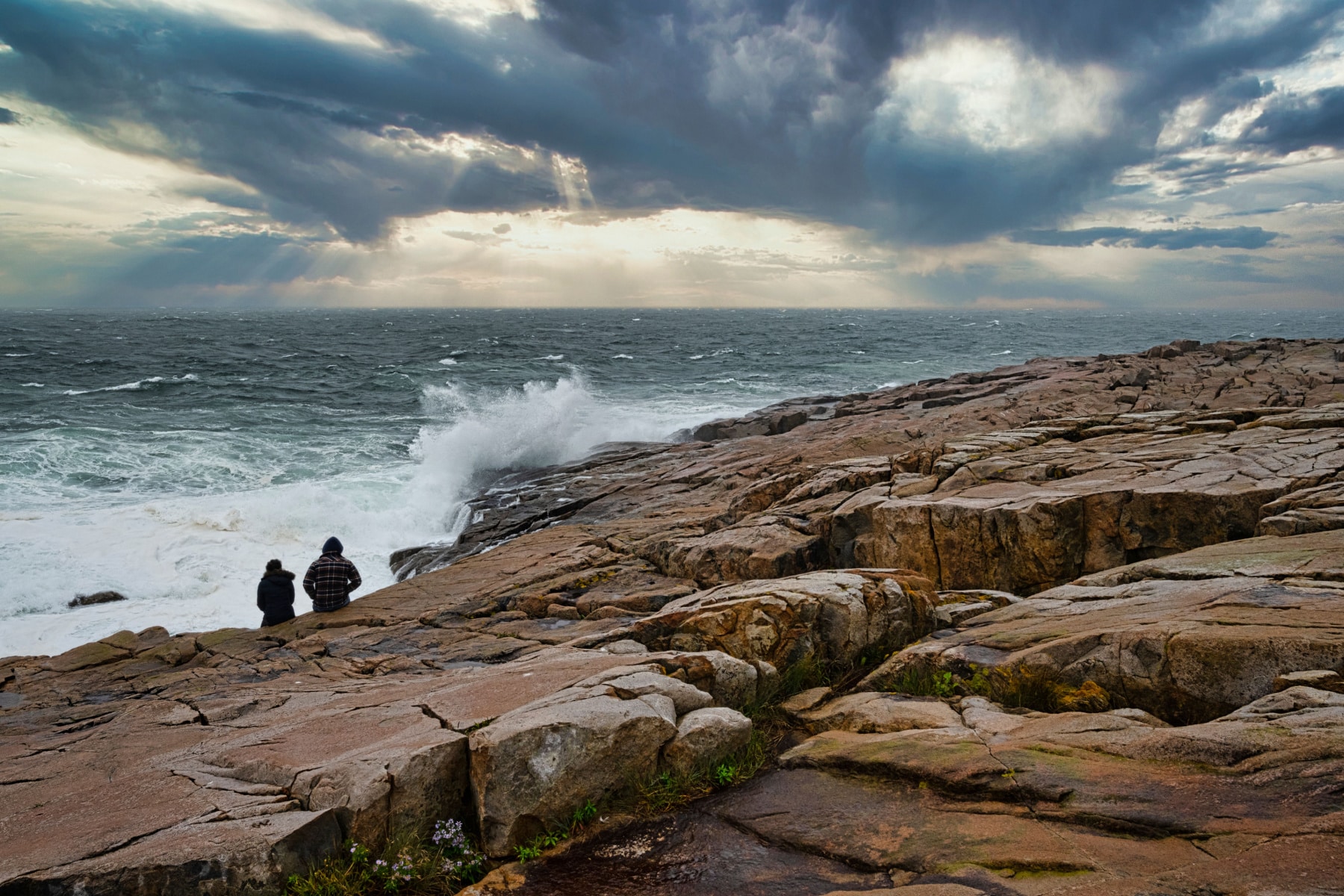
Getting Around Acadia in Winter
Having your own vehicle is ideal since the Island Explorer shuttle system stops running in the fall. An all-wheel drive or four-wheel drive vehicle would be ideal, but roads are plowed and cleared each day.
You’re allowed to walk as far as your legs can carry you, but consider other ways to get around.
Snowmobiles
Now, one of the best parts about the bulk of Park Loop Road being closed to automobiles in winter is that snowmobiles are allowed on the full 27-mile route.
One important note – no snowmobile rentals are available in the park or Bar Harbor. Either bring your own or touch base with the Maine Snowmobile Association to find a rental on your way to the park.
“No snowmobile rentals are available in Acadia National Park or Bar Harbor.”
Park rangers tell us the best spot to start your snowmobile adventure is at the Hulls Cove Visitor Center parking lot.
TAP HERE TO READ SNOWMOBILING RULES & LAWS FROM NPS
- Maine snowmobile laws are enforced in the park. Maine registration is required. Side-by-sides (ATVs) are not allowed.
- Stay off the carriage roads, except for the east side of Eagle Lake, which is only used to make the connection to the Park Loop Road at Bubble Road.
- Snowmobiles are not permitted off-road or on any hiking trails.
- Maximum speed is 35 mph on Park Loop Road and 25 mph on unpaved roads.
- Yield to anyone not on a snowmobile.
- Turn on your white headlight and red tail light 1/2 hour after sunset to 1/2 hour before sunrise and whenever visibility is less than 500 feet.
- No towing of people on skis, sleds, or tubes is allowed.
- It is illegal to operate snowmobiles while under the influence of alcohol or drugs.
- Drivers must be at least 14 years old to operate snowmobiles in the park.
- Anyone under 18 years old must wear approved protective headgear.
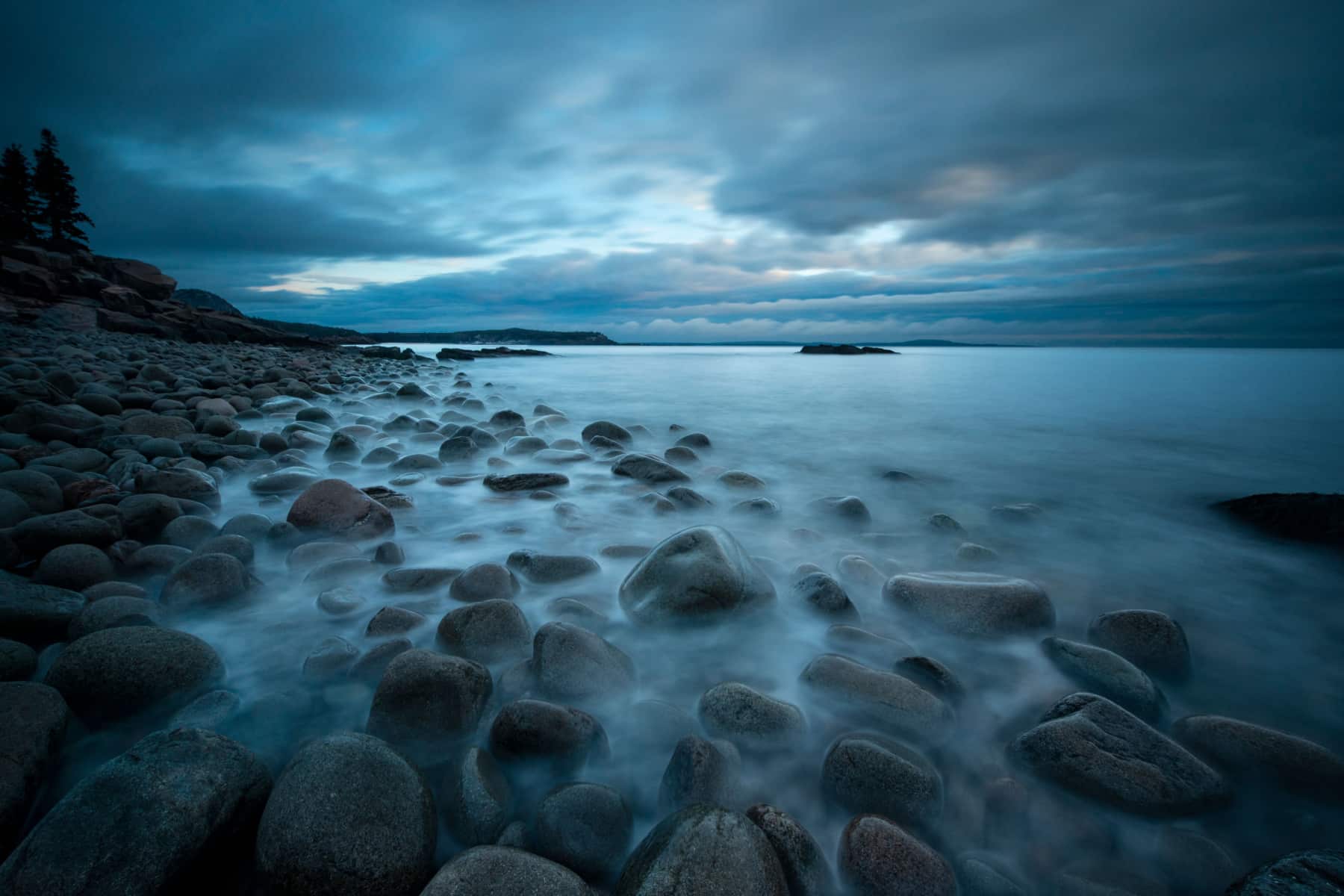
Bar Harbor – Winter Harbor Ferry
The Bar Harbor to Winter Harbor (Schoodic Peninsula) ferry runs daily with four routes from 9:00 am to 3:30 pm departing Bar Harbor. The last Winter Harbor ferry leaves at 4:30 p.m. Tickets run about $20.
- Departs/Arrives Bar Harbor from the Bar Harbor Inn Pier at 1 Newport Drive.
- Departs/Arrives in Winter Harbor at Schoodic Marine Center, 88 Sargent Street.
Arrive 45 minutes before your scheduled trip, and you’ll have to find parking on your own in Bar Harbor (not a problem in winter).

Cadillac Mountain Winter Summit
Cadillac Mountain in Acadia National Park commands attention any time of the year – and who needs roads, right?
Despite the cold, winter brings one thing those summer tourists can’t get at the top of Cadillac Mountain – all winter long, the first rays of each day shine first at Cadillac’s summit.
Winter reservations for the sunrise aren’t required, but that’s mainly because the road to the summit is closed. If you want to see the famed view 1,530 feet up, get ready for a seven-mile hike roundtrip.
The sunset isn’t so bad, either.
With several hiking routes to choose from, expect low crowds and challenging terrain. The easiest option takes you right up the road that vehicles use the rest of the year. We recommend you plot your course with a map of Acadia National Park.

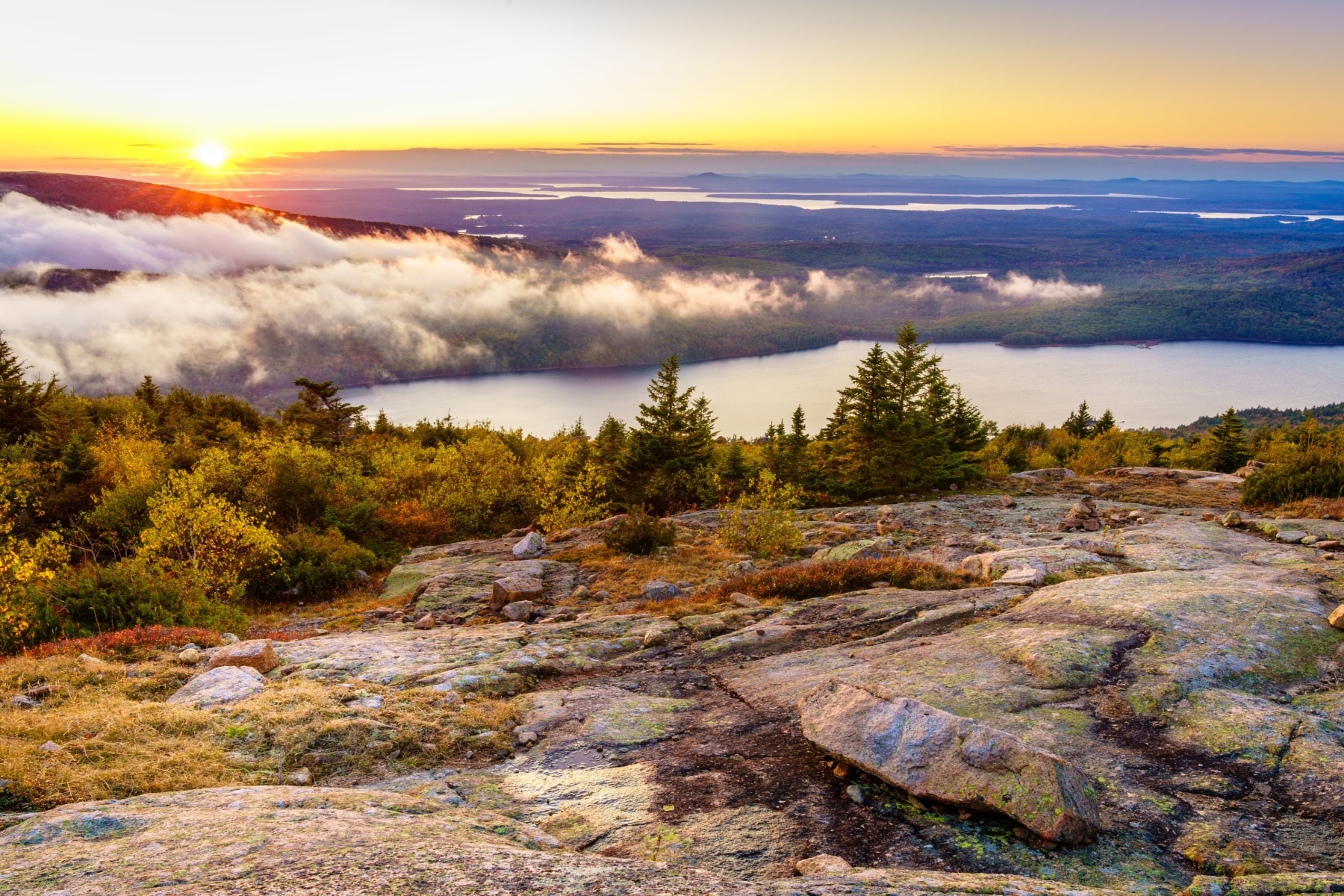
Why Is It Called Cadillac Mountain? Because “Antoine de la Mothe Cadillac Mountain” would have been a mouthful. While it was first named Green Mountain, the name was changed in 1918 to honor the French explorer with the long name above. Cadillac also founded Michigan, which is why the city of Cadillac and the auto company used that signature name.

Winter Activities at Acadia
Acadia in winter is ideal for cross-country skiing, snow hikes, and snowshoeing. Even dogs are welcome on the 45 miles of carriage roads. Extreme activities include ice climbing and climbing Cadillac Mountain.
What is a Carriage Road?: The carriage road system was designed by John D. Rockefeller Junior. The idea was to create a road network that would never be impacted by vehicle traffic. The carriage roads were designed to blend in with the landscape and offer a unique scenic view through all seasons.
Skiing/Snowshoeing Acadia
First, check with Friends of Acadia on Facebook to see what the trail conditions are on the day you plan to visit. More information about trails, rules, and updates can be found at the Ski Acadia website or by using #skiacadia.
Second, the park also allows cross-country skiing on Park Loop Road. Remember, you’ll be sharing that road with snowmobiles, too. They should yield for you but never assume.
Unlike snowmobiles, Bar Harbor offers plenty of rental gear to snowshoe, ski, or trek through Acadia National Park’s carriage roads in winter.
Our recommended carriage road routes are:
- Beginner, West side of Eagle Lake: At less than seven miles, you’ll take an easy path along the lake or ON the lake if it’s frozen over. Also, consider the Amphitheater Loop, which is just five miles away with forest and ocean views. For first-timers, the Paradise Hill loop keeps you closer to Bar Harbor.
- Moderate, Aunt Betty Loop: Six splendid miles with some incline challenges offer more water/ice features and wildlife possibilities than most trail sections.
- Expert, Around the Mountain: Get ready for a day of skiing challenging hills and past some of the most remote features of Acadia in winter. With more than 12 miles to tackle, you’ll need stamina and winter skills.
What Would Carriage Roads Close? It’s important to know the trail status because the carriage roads can close due to bad weather, damage after a storm, or when allowing travel on the roads could lead to trail damage. This is one reason why the carriage roads close in March through April during “Mud Season.”
Finally, the photos below from Acadia NPS give you an idea of what to expect on the carriage roads in winter.



Acadia Winter Hikes
Beyond walking or snowshoeing the carriage roads, all the hiking trails you can reach are up for grabs.
Keep in mind that the strenuous trails of summer because that much more foreboding in winter, especially places like Beehive and Precipice that require climbing ladders and using rungs.
Coastal Trails
- Great Head Trail: This is a moderate 1.7-mile loop trail that offers stunning views of the ocean and Sand Beach. It’s a great option for beginners and experienced hikers alike.
- Ocean Path: This easy 4-mile round-trip trail takes you past Thunder Hole and Otter Cliff, offering beautiful views of the coastline. Be sure to check the conditions before you go, as the trail can be icy in the winter.
- Ship Harbor Trail: This easy 1.3-mile trail is a great option for a short hike. It winds through the woods and offers views of the ocean and Somes Sound.
Tap on the photo below to check out our favorite hikes in Acadia National Park.
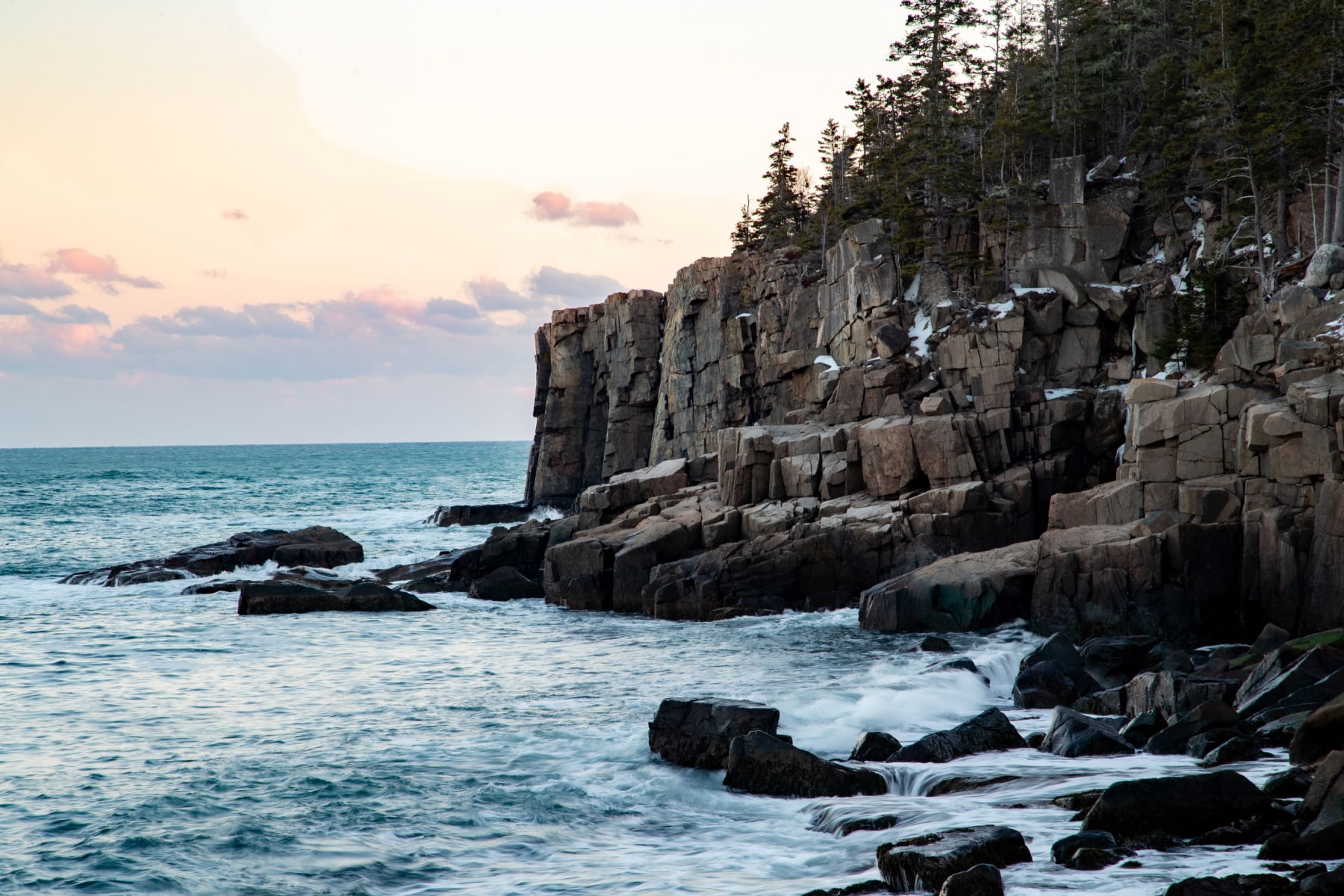
Ice Climbing
If hanging off the edge of a cliff wielding an ice ax sounds like fun, you’re going to love what awaits at Acadia. Places like Otter Cliffs, The Precipice, and South Bubble continue to offer excellent climbing options even in the depths of winter.
Outfitters like Acadia Mountain Guides are ready to help you plan the experience based on your skill level.
Ice Fishing
Most of the ponds and lakes freeze over in Acadia National Park, offering a great chance for some ice fishing. The season runs from January through March, and you’ll need a Maine fishing license.
For a more turnkey experience, book a tour with places like Acadia Fly Fishing. They set up everything – you show up and catch fish.
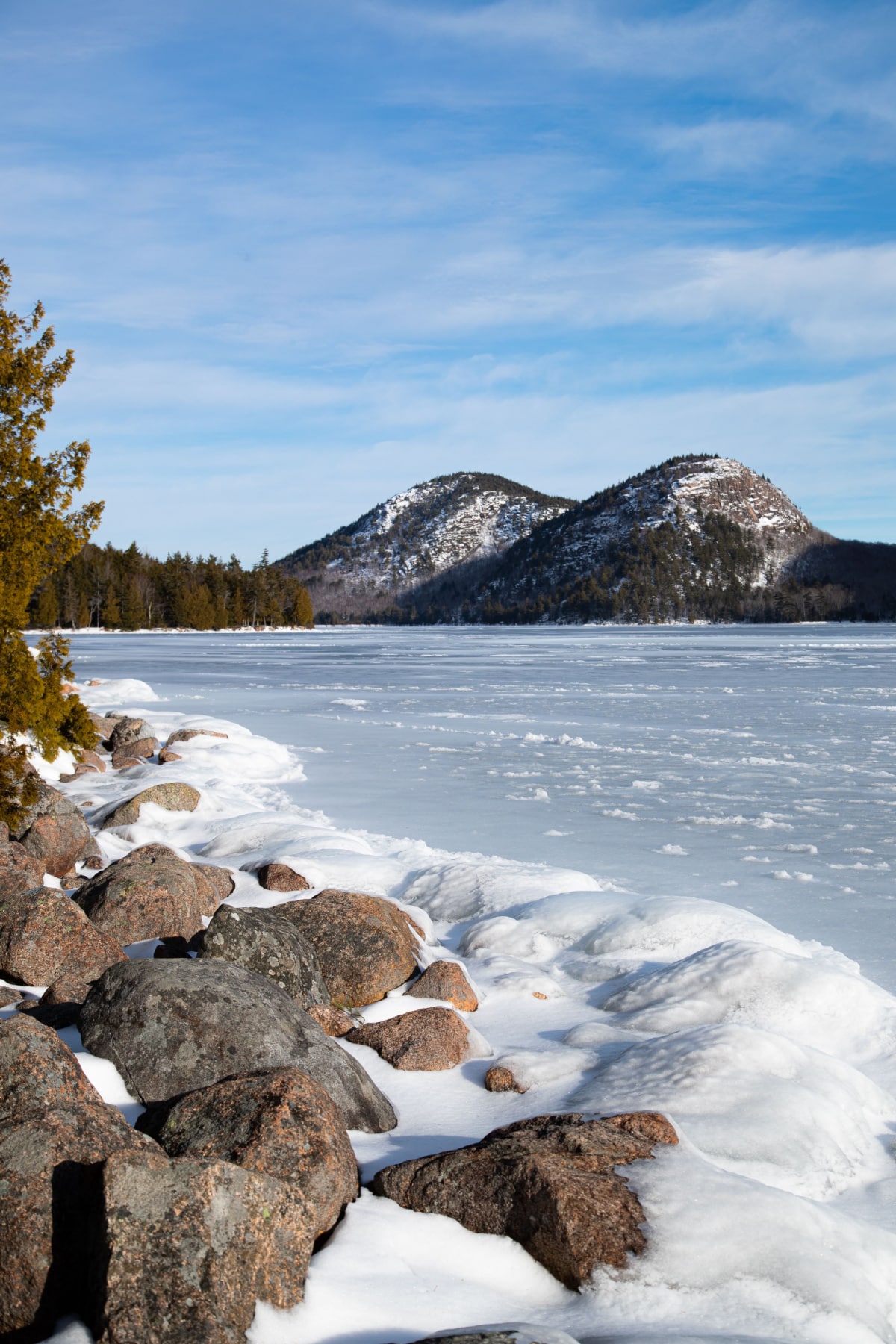
Scenic Drives
As discussed above, a great scenic section of Acadia National Park stays open in the winter. However, more adventures await.
Schoodic Peninsula National Scenic Byway
On the way to the Schoodic Peninsula, you’ll drive the Schoodic National Scenic Byway. It stretches for 35 miles, including the loop portion in Acadia National Park.
Check the tide schedules for Tidal Falls Preserve, where you can see the “reversing falls,” one of only eight found throughout Maine’s coastline.
“SOMETIMES, BETTER IS DEAD”: If you know what book/movie that is from, you’ll love this! Go two miles off Route 1 on Point Road in Hancock. The house used in Stephen King’s Pet Sematary movie is located at 303 Point Road. It is privately owned, but there’s a small pull-out to look at the house if you want to snap a photo.
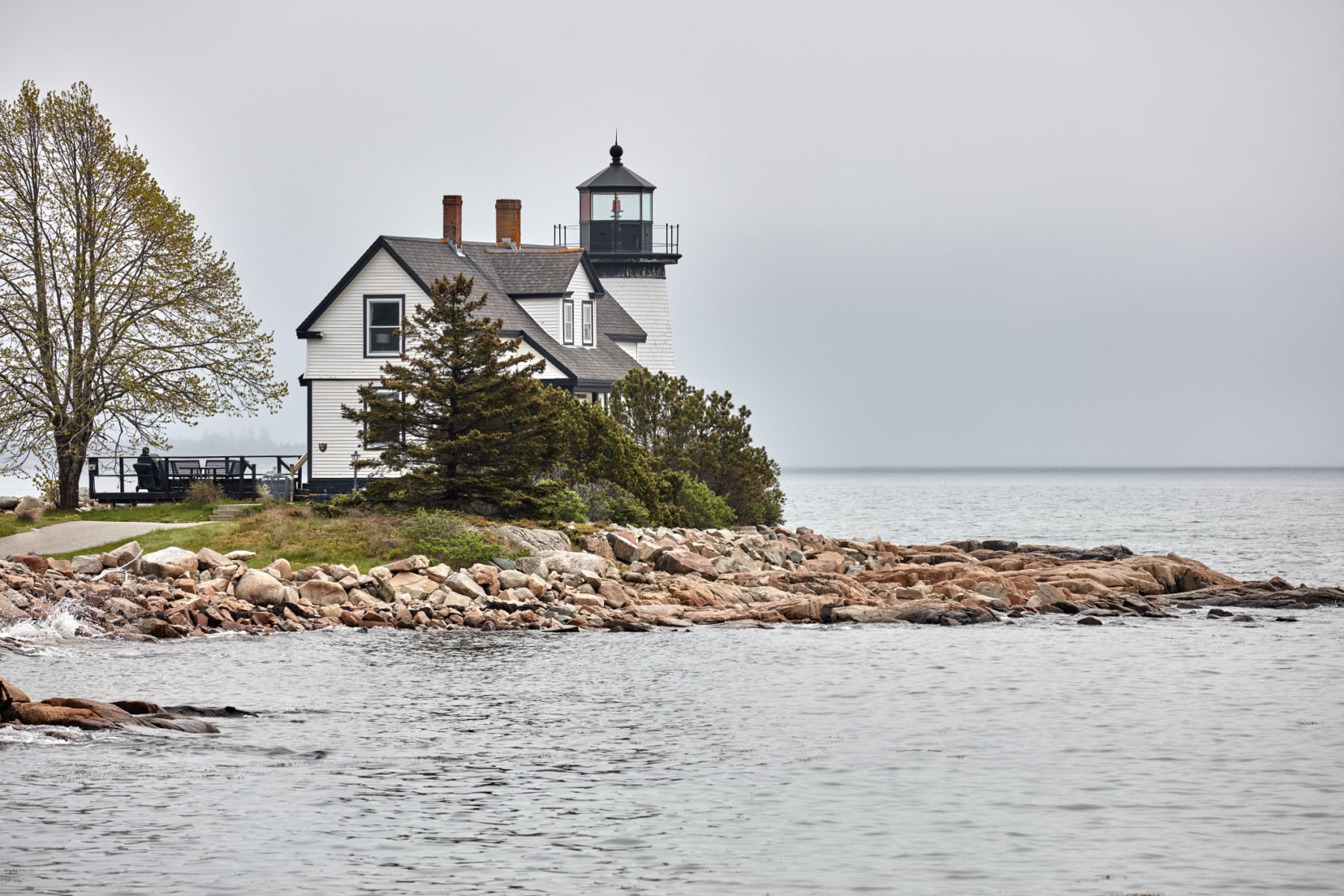
Sargeant Drive on Somes Sound
Over by Northwest Harbor, you’ll find my favorite scenic section in winter. Take Sargeant Drive, which straddles the eastern edge of Somes Sound. The two-lane road becomes an explosion of winter wowza. On one side, the water ripples to the rim of the rocks lining the road.
On the other side, ice formations dangle, drip, and delight on sheer cliffs. In between? Snow-heavy trees line the way. Tuck this one away for stunning fall drives, spring blooms, or summer “top down” cruises.
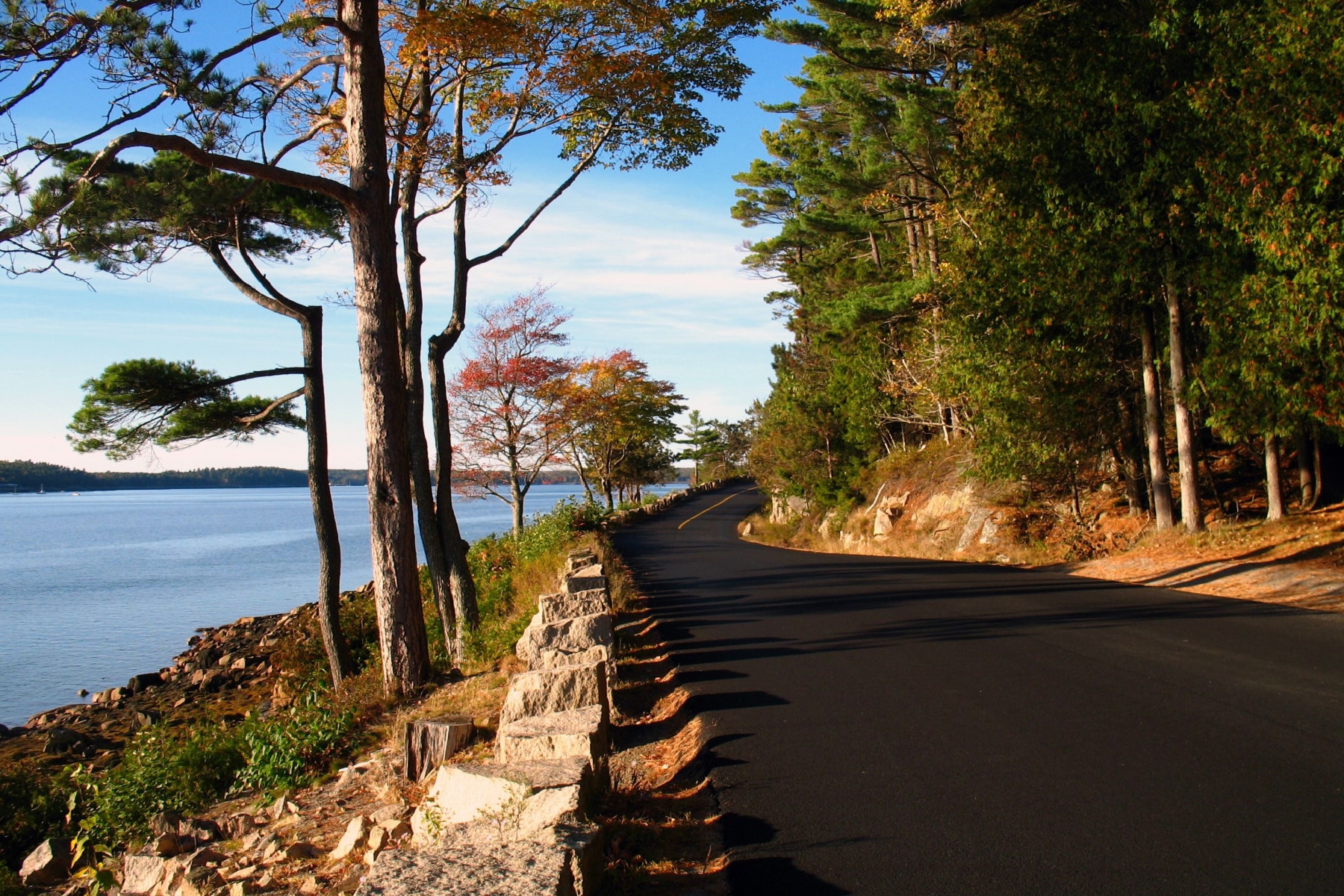
Seawall in Acadia
One of the first roads to feel the impact of an incoming storm is Seawall Road near Southwest Harbor. This five-mile stretch of road takes you right to the edge of the tide. Bundle up at night to soak in the night skies from this vantage point.
As we mentioned earlier, the Ship Harbor Trail is one of the best winter hikes in Acadia, and it’s right off this road.

Bass Harbor Sunset
During summer, you’ll struggle to find a parking spot or even get a moment of peace with the groups that crowd Bass Harbor Lighthouse at sunset. Winter in Acadia brings the best opportunity to savor Bass Harbor’s sunset in all its glory.
A small parking area awaits with a short walk through woods to the coastline. One important note – the best spots come with precarious steps. You’ll stand (or sit) on tiers and steps of the rugged coastline. My nerves took over when I couldn’t wear crampons on the slick rock but needed them for the snow and ice – all within inches of each other.
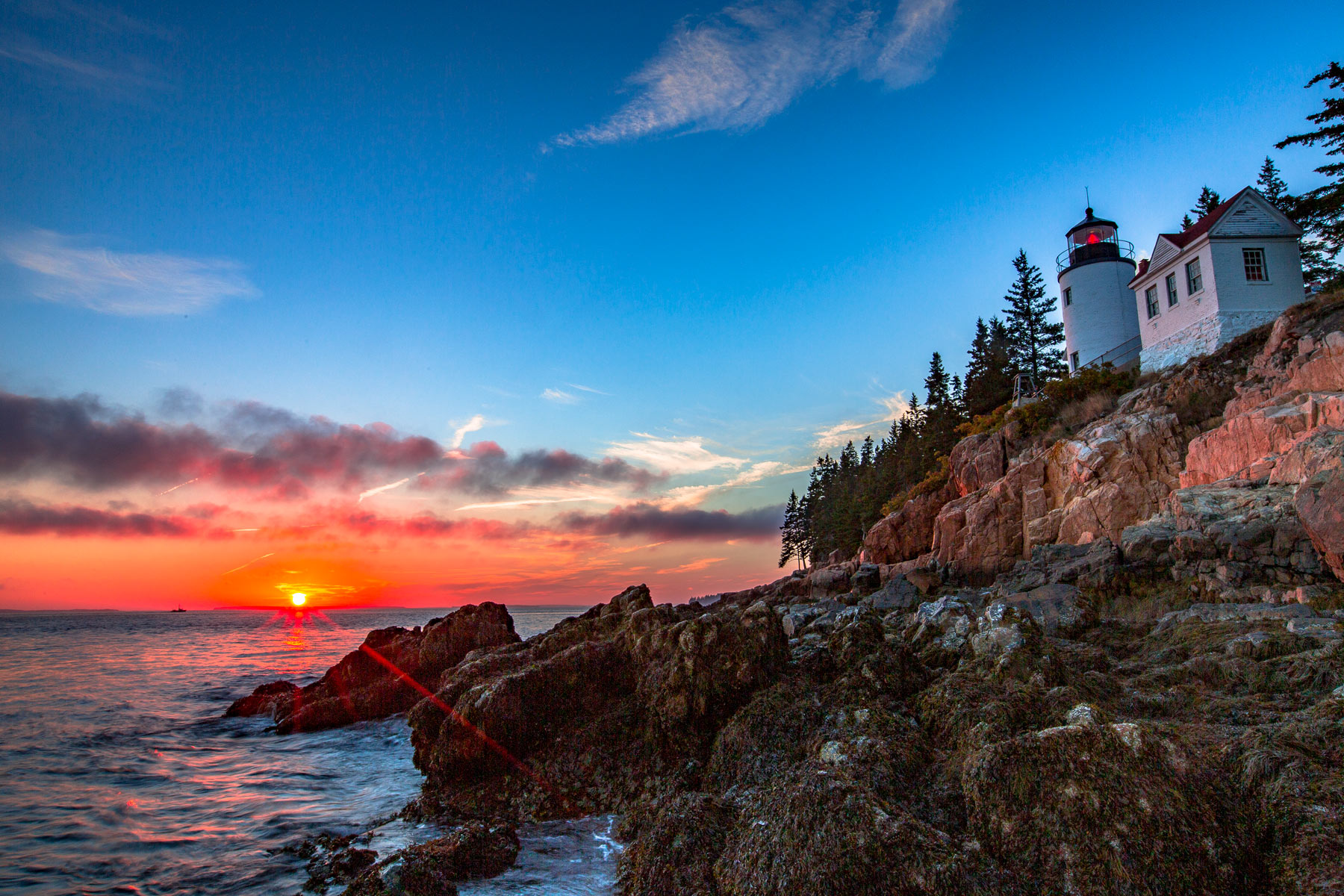
Winter Sunrise and Sunset Times in Acadia
Now that we’re all excited to visit Acadia in the winter, I’m offering another dose of reality. Considering how far north Acadia National Park is, the sun will set much earlier than you might expect – as early as 3:53 pm.
| Sunrise | Sunset | ||
| December | 6:55 am | 4:00 pm | |
| January | 7:05 am | 4:30 pm | |
| February | 6:30 am | 5:00 pm | |
| March | 6:45 am | 6:40 pm |

Pet Rules at Acadia in Winter
Dogs on a six-foot leash love exploring the trails and carriage roads. Acadia offers one of the most dog-friendly national park experiences in the nation.
If you are bringing a pet, be responsible. Pick up after them and carry the waste with you until you can properly dispose of it. Do not leave it bagged on the trail or toss it into the woods. Responsible pet owners and dogs can earn the title of B.A.R.K. Ranger. As a pet parent myself, I love that Acadia allows pets to enjoy the splendor on these roads.
A few pet rules to note:
- Leashed dogs are allowed on Sand Beach in the winter but not in the spring or summer (June 15 – September 8).
- Keep dogs off any ladder trail, like Precipice, Beehive, or Dorr Mountain. Here’s the full list of restrictions.
- Even though it’s winter, a full-body scan for ticks is necessary after a hike.
On a related note, the six-foot leash law is one reason dog sledding isn’t allowed in Acadia National Park.
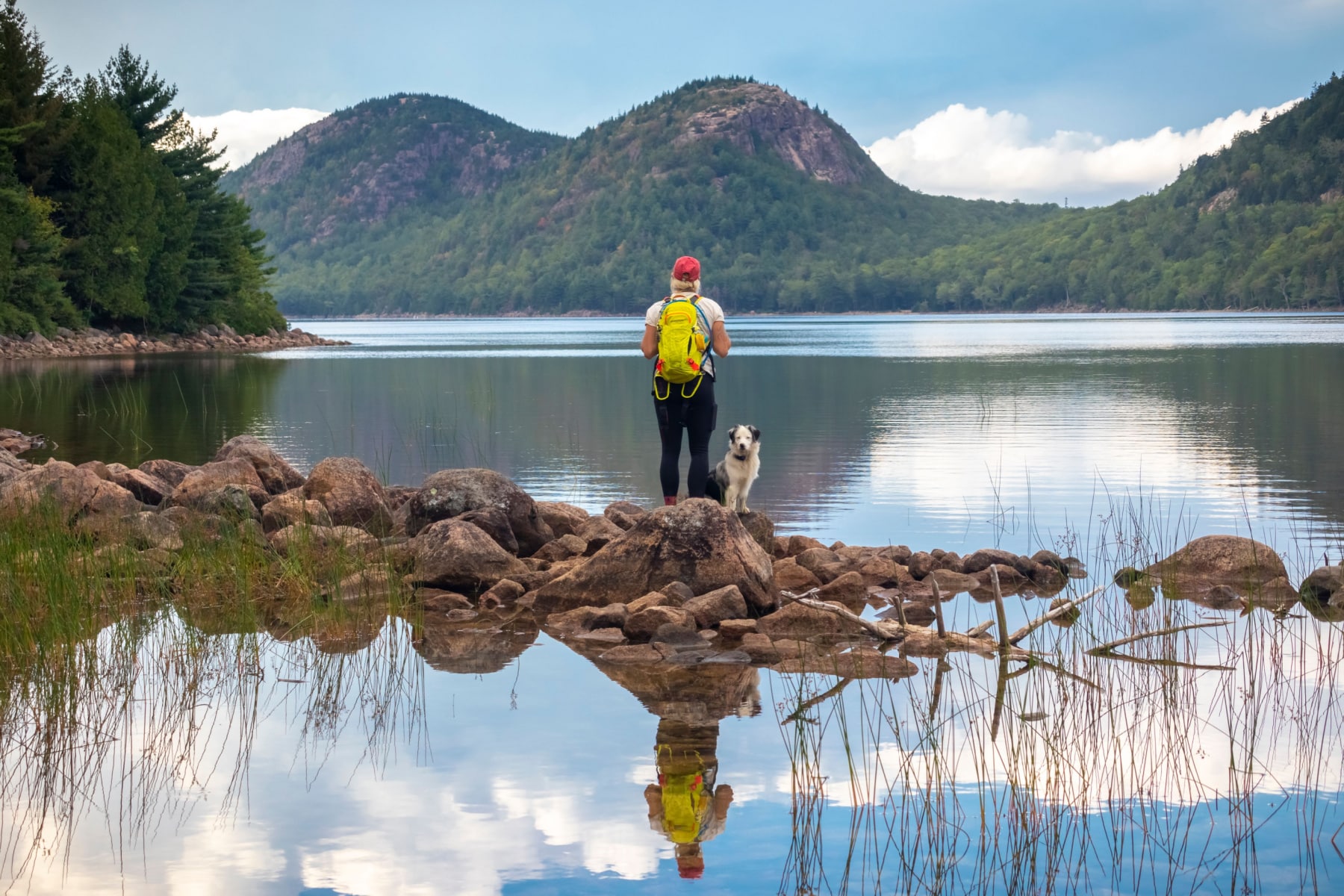
Is Acadia REALLY Worth a Winter Visit?
Our mission at More Than Just Parks is to share the love of public lands but also not oversell or diminish any aspect of a park. The only motivation is to help YOU plan a trip and start conversations.
Let’s go through the pros and cons of visiting Acadia in winter.
Pros of Acadia in Winter
- Smaller Crowds: The busy summer months bring in around 760,000 people, with peak visitation in July or August. Looking back at the past five years of visitation data, December – March saw anywhere from 10,000 – 20,000 each *month. That means the crowds are 89%-98% less.
- A Winter Dream: Acadia offers the fun of snow, like you’d get at Yosemite, but without accumulations by the foot. Then, add in the stunning ocean scenery, from Sand Beach to ragged shores with crashing waves. At the same time – dress for the cold. As they say in Maine, “There’s no bad weather, just bad clothing.”
- Variety: Instead of trails being EITHER skiing or hiking, you get carriage roads and hiking trails. If the park roads are closed, take the state roads and explore the coastal towns like Tremont and Southwest Harbor.
Cons of Winter in Acadia National Park
- No Camping: While camping in bitter cold isn’t my thing, so many people in my group of friends are bummed you can’t camp at Acadia anymore. Without a nearby option, you have to drive at least an hour or two to find a campsite.
- Limited Accommodations: Our favorite place to stay in Bar Harbor isn’t open during the off-season. You’ll find that a handful of great options are open, but prepare for more hunting and pecking to find the right spot.
- Unpredictable Weather: This con goes for many parks, not just Acadia. If a nor’easter is approaching, the roads and trails could be pre-emptively closed, then closed during the storm, and then closed for days afterward to clean up. (Maybe offer to volunteer!)
I purposely left off the closure of roads to vehicles because the park’s footprint isn’t minimized that much – it’s just how you choose to get around. Snowmobiling is a game changer once you learn how to use the ride.
With the traffic in the summer, you will likely cover more ground on skis anyway.
FEBRUARY WINTER BREAK: Visiting Acadia in February should be on your short list of things to do during the winter break week for New England schools.

WATCH: The Acadia Film in 4K
This film is the culmination of several weeks spent exploring Acadia National Park during peak fall color.
It is dedicated to George Dorr, who was instrumental in saving the land and founding the park. Journey with us as we explore this magnificent coastal wonderland in stunning fall color.
We’d sure appreciate it if you’d subscribe to our YouTube Channel or share it with your friends if you enjoyed the film.
Planning an Acadia Trip? We Can Help
Our team explored Acadia in every season and we’re not playing favorites. This guidance should get you started.
Quick Resources: Things to Do / Guide / Hikes / Map / Guidebook / Where to Stay / Facts
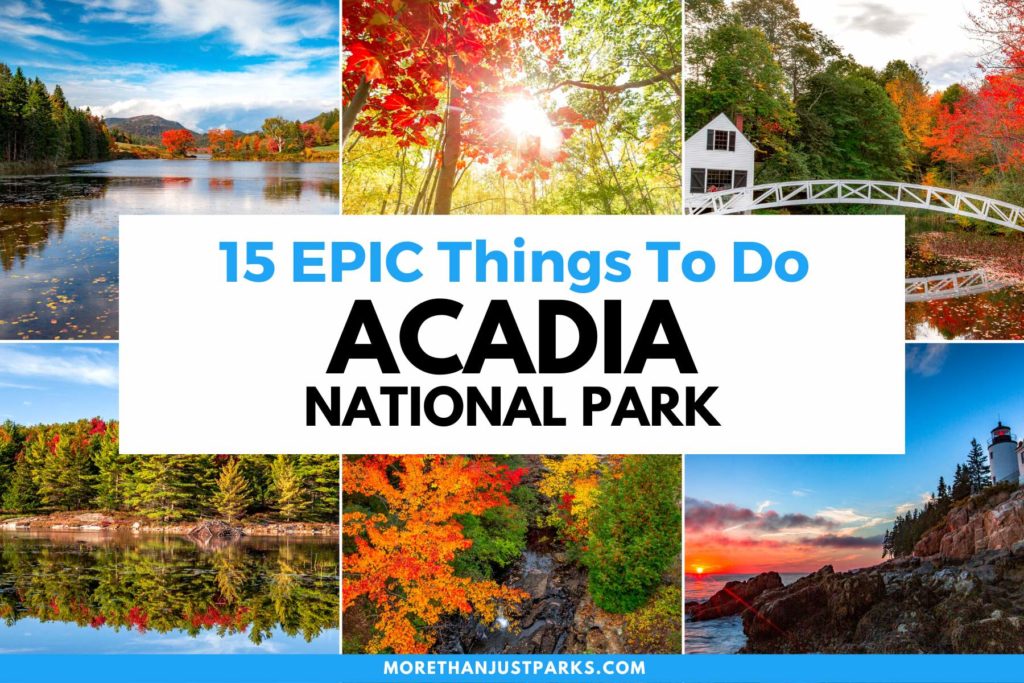
Pin Acadia in Winter
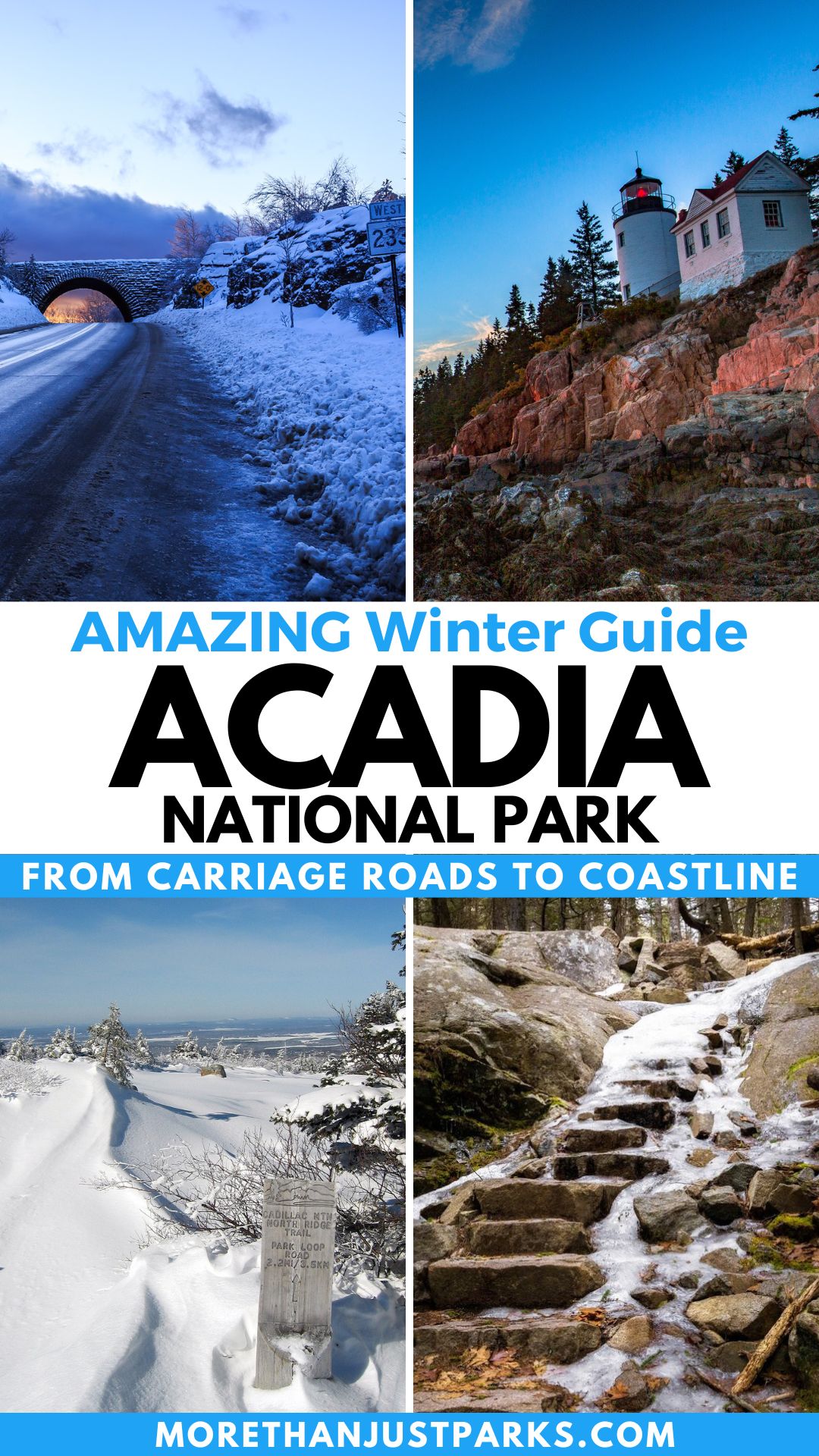
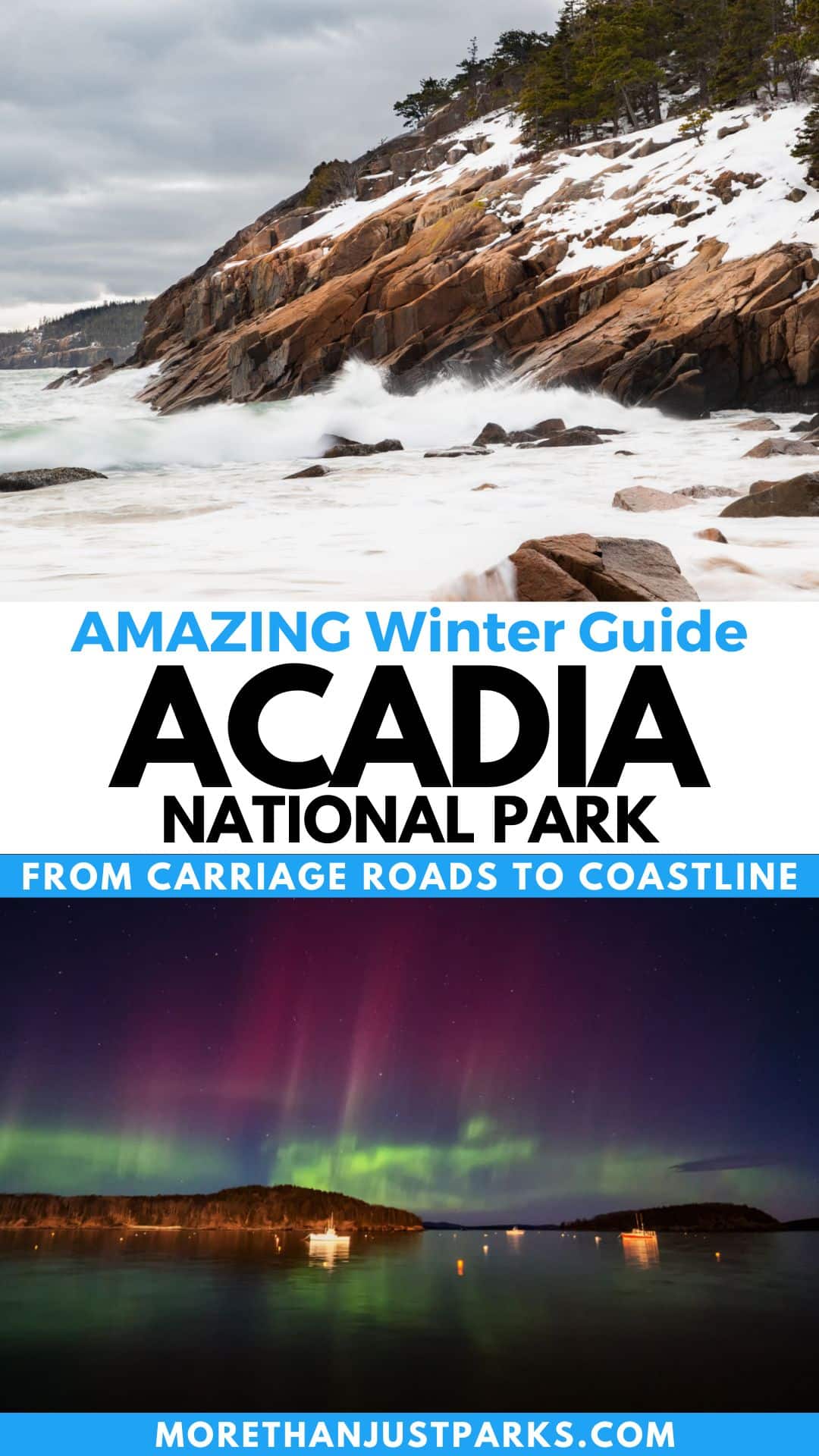
Helpful Related Links
Best National Parks in Maine: 6 EPIC Maine National Parks Worth Visiting
Top National Parks Next Door in New Hampshire: These EPIC New Hampshire National Parks Are Worth Visiting
Precipice vs Angels Landing: An Honest Guide to Angels Landing in Zion National Park
Precipice vs. Half Dome: An Honest Guide to Half Dome in Yosemite National Park
National Parks Rankings: ALL 63 US National Parks Ranked By Experts
Most Visited National Parks: Top 10 Most Visited National Parks
Least Visited National Parks: Top 10 Least Visited National Parks
National Parks Road Trips: 10 Best National Park Road Trips
National Monuments Ranked: ALL 128 US National Monuments Ranked (Best to Worst)
Best Winter Parks: 15 Stunning National Parks in Winter Worth Visiting (+ Photos)
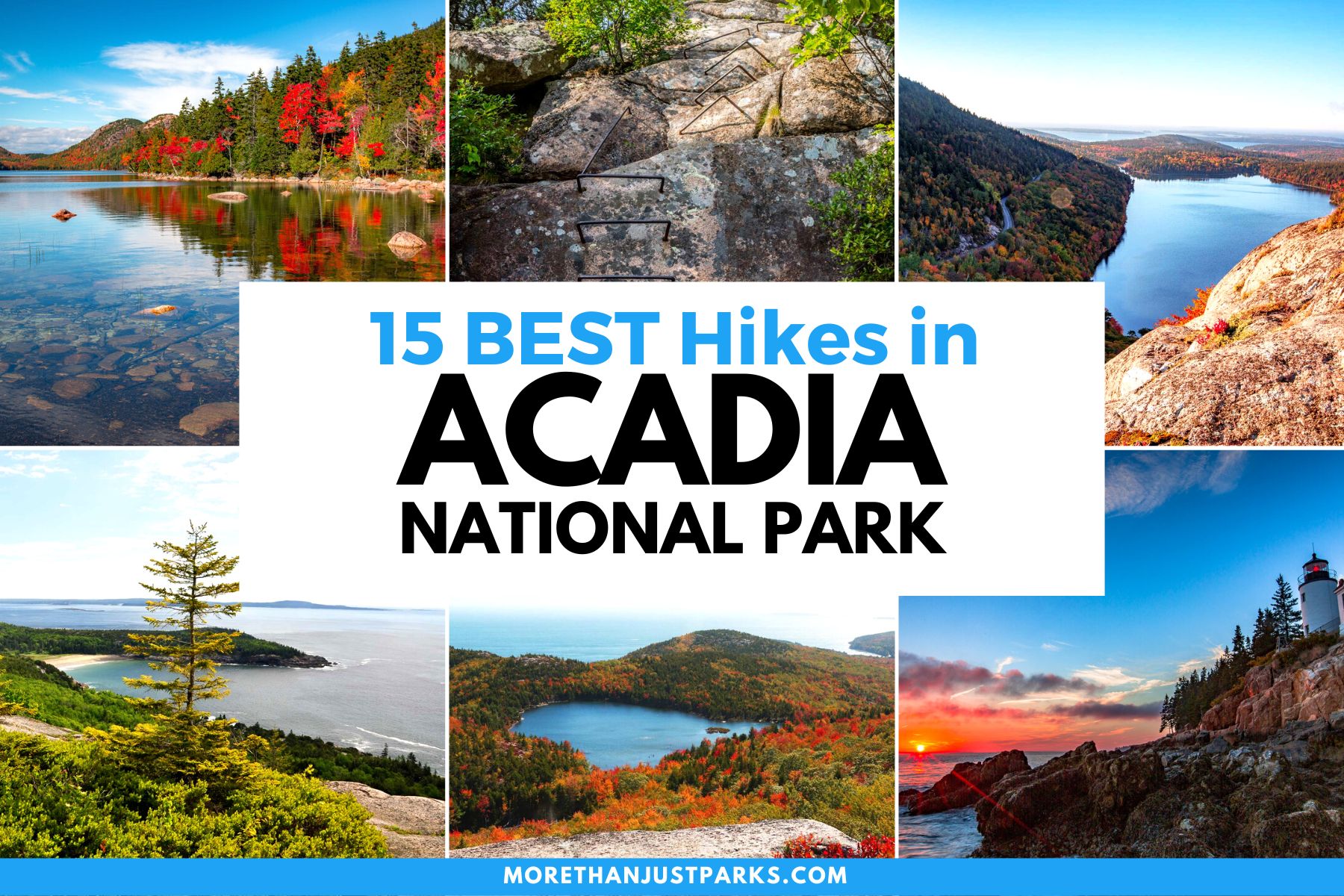
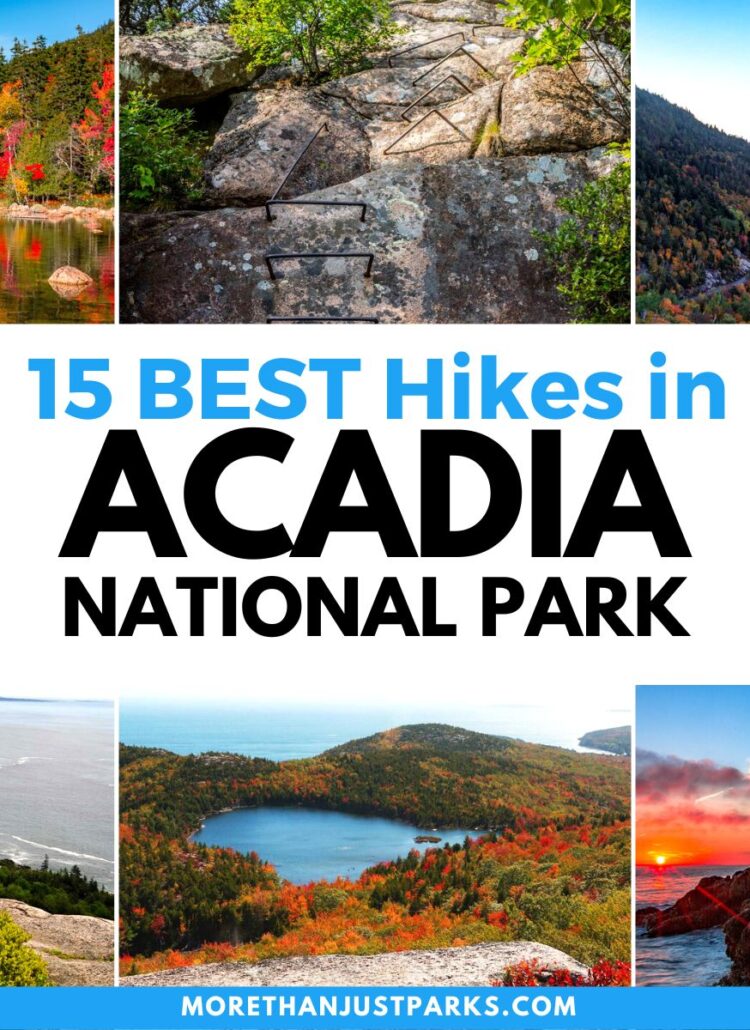
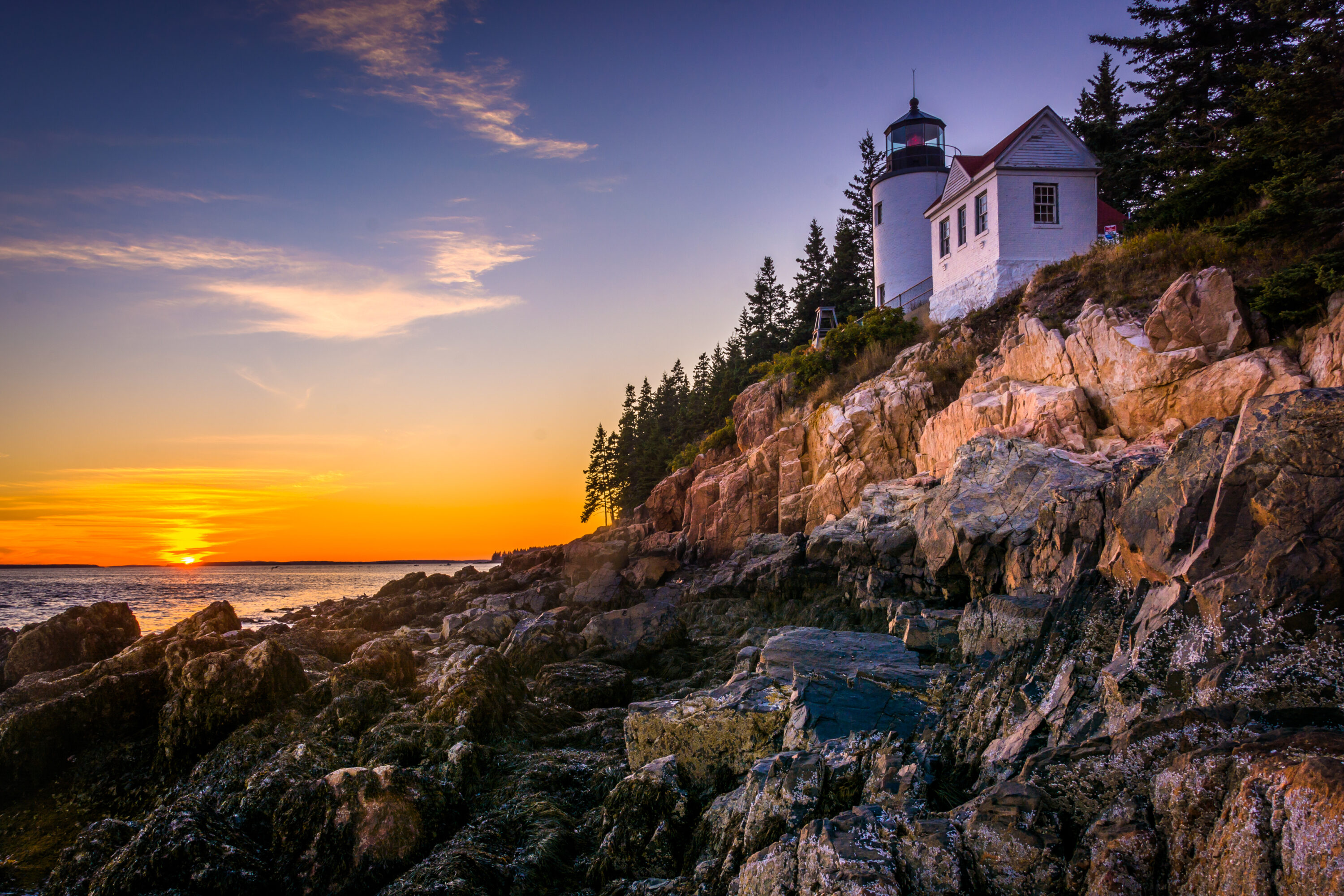
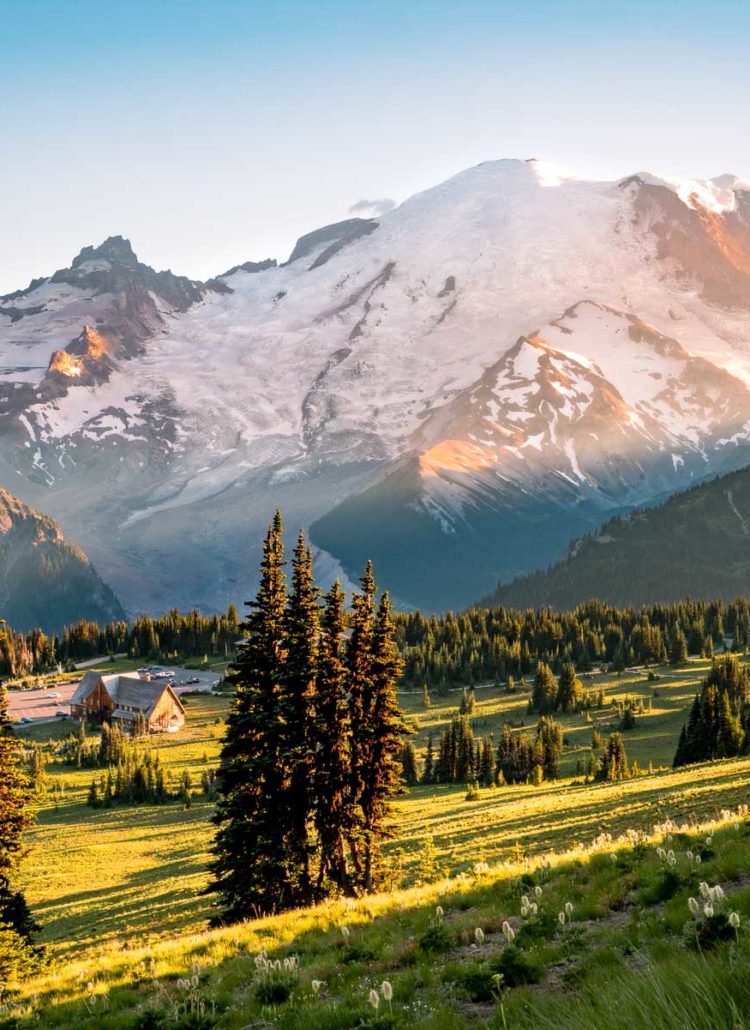
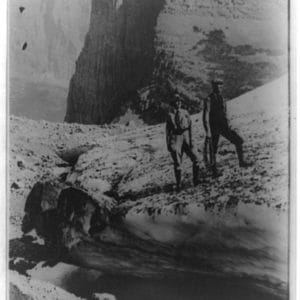

Leave a Reply